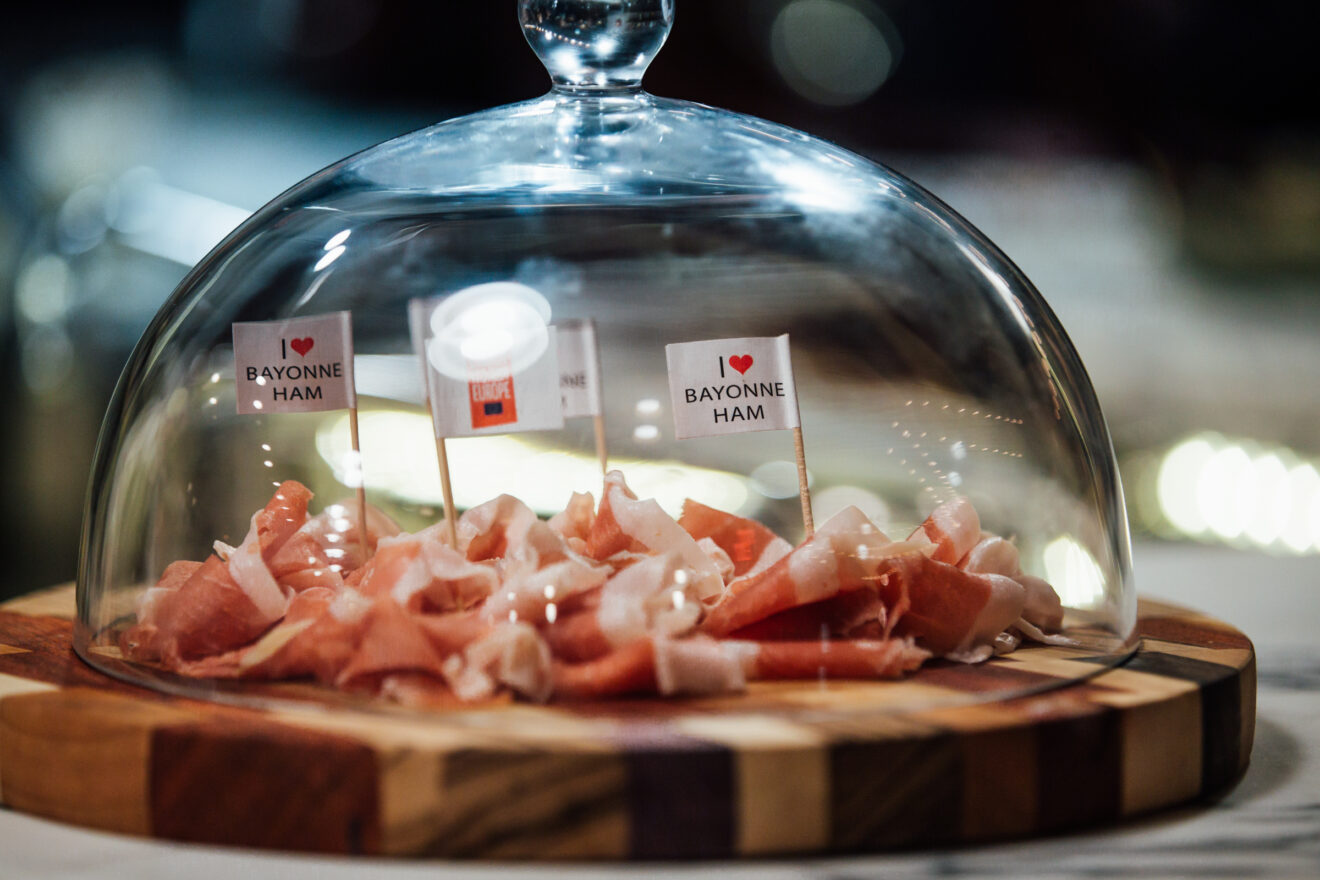This post is sponsored by The Bayonne Ham Council.
Just as Italy has Parma ham and Spain is famous for Iberico ham, France has a signature pork product that is gaining a following stateside. Bayonne ham — also known as jambon de Bayonne — has been made in the Southwest of France for more than 1,000 years using the same painstaking process, which results in a unique, moderately salty cured ham with a range of culinary applications. In this interview, Bayonne Ham Council US brand ambassador Florane Gambert-Jouan discusses what makes it stand out from other hams and how Bayonne ham is building its reputation among US chefs and consumers.
What classifies a ham as Bayonne ham, and what sets it apart from other hams?
Bayonne ham is a dry cured ham from the Southwest of France. The region is characterized by the meeting of the temperate, humid oceanic climate coming from the Atlantic and the drier air from the Pyrenees. This creates the perfect production conditions. According to legend, a hunter named Gaston Febus wounded a wild boar that ran off only to be discovered months later perfectly preserved within the Natural Spring of the Adour Basin.
Four ingredients are essential for the production of Bayonne ham: pig, salt, air and time. The pigs used for Bayonne ham are bred locally, in the area around the Adour Basin. Salies de Bearn salt is obtained exclusively through the evaporation of salty spring water from the Reine Jeanne D’Oraas spring, between the sea and the mountains. Salies de Bearn has been trapped beneath the Pyrenees for millions of years and preserved in water at concentrations 10 times that of seawater.
The harmonious union between the freshest meat and natural salt gives Bayonne ham a truly unique and distinguishing flavor, sweet with a creamy finish. On average it takes nine to 12 months to make the Bayonne ham.
Bayonne ham earned the Protected Geographical Indication status in 1998. This European label guarantees the quality and geographic origin of a given product. Its focus on transparency allows consumers to trace exactly where their food comes from, helping prevent food fraud. At the level of the manufacturers, the PGI protects regional and traditional practices.
Bayonne ham became available in the US in 2015. What brands are available here and how have export volumes grown since its introduction?
Bayonne ham is the first French dry cured ham available on the US market. The available brands are Maison Agour, Delpeyrat, Mayte, Salaisons de l’Adour and Pierre Oteiza.
Volumes have doubled since its launch on the US market in 2015. It started with expansion on the East Coast, but the presence of a huge Basque community on the West Coast helped its expansion there.
How is the Bayonne Ham Council raising awareness of Bayonne ham in the US?
The Bayonne Ham Council’s role is to protect and promote the presence of Bayonne ham in the US. BHC has participated in a lot of food shows, including the Fancy Food Show, Congress Maitre Cuisinier de France and Annual StarChefs International Chefs Congress, to name a few. The Council also makes sure to keep customers and followers informed of their journey on social media via Instagram, Facebook and Linkedin.
At the Winter Fancy Food Show last month in San Francisco, the Council hosted the first USA-held Confrerie du Jambon de Bayonne induction ceremony.
The purpose of this ceremony was to recognize and thank those who were inducted for their hard work and dedication to the product since its arrival on the US market and make them the official new ambassadors for Bayonne ham in North America. Their role is to promote the authenticity and culture that lies behind PGI Bayonne ham. As such, they usually take part in various celebrations and events around jambon de Bayonne such as Foire au Jambon and Fetes de Bayonne. It was a great success!
How are US chefs featuring Bayonne ham on their menus?
Jambon de Bayonne has a strong identity. It has graced some of the most famous tables in history, such as those of Marguerite de Navarre, Francois Rabelais and the French kings Henry IV and Louis XIV, all of whom argued fervently for its place at the table.
More than two dozen US restaurants have Bayonne ham on the menu. It is found on the menu of French restaurants paired with other meats on a charcuterie board, served cooked in a croque madame or sprinkled over eggs Benedict. Paired with food or on its own, Bayonne ham is amazing with white or red wine.
The content of this sponsored post represents the views of Jambon de Bayonne and is its sole responsibility. The European Commission does not accept any responsibility for any use that may be made of the information it contains.
_____________________________________________________________________________________________________________
If you enjoyed this article, sign up for Restaurant Smartbrief or ProChef Smartbrief, or check out all of SmartBrief’s food and travel newsletters as we offer more than 30 newsletters covering the food and travel industries from restaurants, food retail and food manufacturing to business travel, the airline and hotel industries and gaming.
